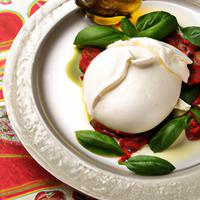
1 serving (125 grams) contains 300 calories, 15.0 grams of protein, 25.0 grams of fat, and 1.0 grams of carbohydrates.

Log this food in SnapCalorie

Nutrition Information
Calories |
600 | ||
|---|---|---|---|
% Daily Value* |
|||
| Total Fat | 50 g | 64% | |
| Saturated Fat | 32 g | 160% | |
| Polyunsaturated Fat | 0 g | ||
| Cholesterol | 150 mg | 50% | |
| Sodium | 300 mg | 13% | |
| Total Carbohydrates | 2 g | 0% | |
| Dietary Fiber | 0 g | 0% | |
| Sugars | 2 g | ||
| protein | 30 g | 60% | |
| Vitamin D | 200 mcg | 1000% | |
| Calcium | 600 mg | 46% | |
| Iron | 0.4 mg | 2% | |
| Potassium | 200 mg | 4% | |
* Percent Daily Values are based on a 2,000 calorie diet. Your daily values may be higher or lower depending on your calorie needs.
Food Attributes
Source of Calories
About Burratta
Burrata is a fresh Italian cheese, originating from the southern region of Apulia. Made from cow's milk, it consists of a delicate outer shell of mozzarella filled with creamy stracciatella—a mixture of fresh cream and soft curds. Its texture is luxuriously smooth, and its flavor is rich, milky, and mildly tangy. While high in protein and calcium, contributing to bone health and muscle repair, Burrata is also rich in fat and calories due to its creamy core, which should be consumed in moderation as part of a balanced diet. Traditionally enjoyed as a staple in Italian cuisine, it pairs well with fresh tomatoes, olive oil, and basil. Though indulgent, Burrata can be integrated into healthier dishes when complemented by fresh, nutrient-rich ingredients.



